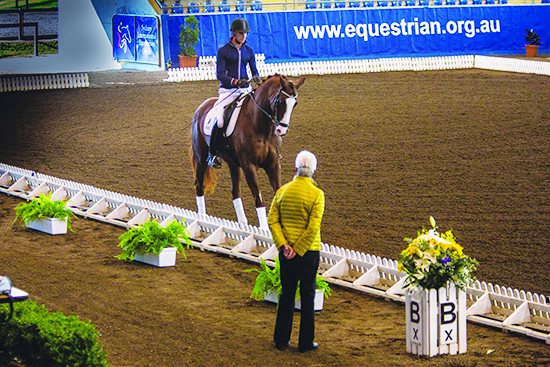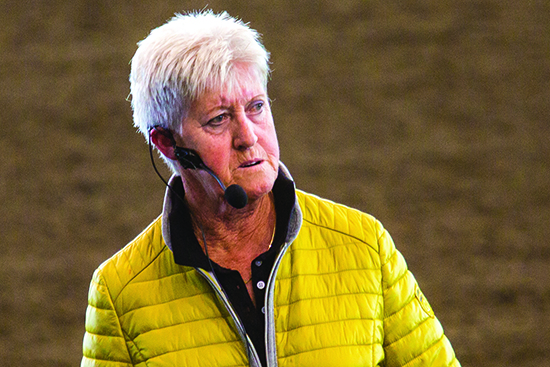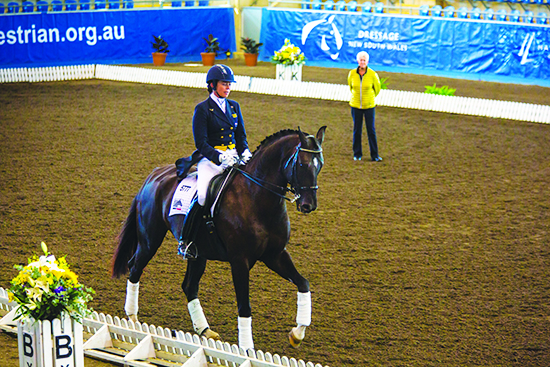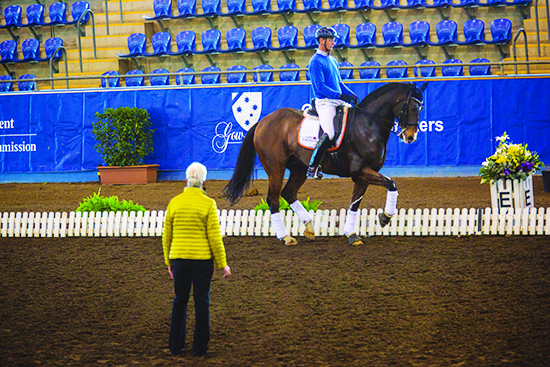Rebecca Ashton sits in on a clinic with Lilo Fore
 Jayden Brown and Fürst Frederich
Jayden Brown and Fürst Frederich
What was to be a clinic dedicated to freestyles, thankfully turned into a clinic based solely on training the horse. A theme more interesting to most of us, it was a lovely opportunity to see some of our top riders work on their problems immediately after we had seen them compete the days before, their performances fresh in our minds. American based judge Lilo Fore took the reins and instructed everyone calmly and expertly, using thoughtful exercises to get harmonious results.
First into the chilly SIEC indoor was Jayden Brown on Fürst Friedrich, presented in a snaffle after what Jayden explained was a stressful night for the 12-year-old chestnut gelding with his first Sydney CDI Grand Prix Kür. Jayden was keen to work on extensions.
Lilo began, “Horses need to have time to have weight bearing in the hindlegs so the shoulders can travel up. Ride the horse from the beginning in balance, but give them a little time to rearrange their body. Good balance leads to good, successful movements. Showing you this today is my goal.”
Lilo had Jayden warm up as he would at home. “I don’t try to take away from your skill and I just want to add to it, but not really drill you.” The Queenslander proceeded with a loose trot, canter and some leg yield, but Lilo was a little unhappy with the horse’s head carriage. “I like his position but I want to keep his chin off his chest. This affects his shoulders and your seat is just a fraction behind. Even in the warmup, I like to do the opposite of what the horse wants. If he likes to fall on the forehand, I like to ride it up, if it is too high, ride it lower, too lazy, I gallop!”
“When they are in the paddock, no one is there to carry their heads. They have to do it for themselves and it’s the same when we ride them. We are not their leaning post. We’re supportive of them, but not supporting.”
“With the half halts, try to be really sure that you don’t over push with your seat, but hold it with your seat. I would sit a little straighter down, hold with my core and then use my gas pedal, the leg. The rein is the last piece. I want a good contact, but not a leaning contact. This has something to do with your extensions too. We don’t want the horse to get faster and run, but to lift up and out, so be a little bit careful not to lean back. Then the horse can not only keep the poll the highest point, but also the shoulders. Keep your body upright and then just your legs lift him up. Get the collected trot more active and let him swing to the reins. We need a quicker tempo, Jayden.”
Lilo, like we hear from all the top trainers, wanted corners used to their full advantage. “Let the corner help you keep the uphill balance, then his hindlegs can work. You should be able to let go of your reins a little over his neck. Don’t keep it too slow.”
“Remind him to stay up and be active behind, and then be quiet. Fix the crime when the crime is committed, but then just give little reminders.”
A break then saw the walk analyzed and the judge had some more advice, “Your arms have to follow from your shoulders. In extended walk, keep his poll the height of the withers or else it is more like a free walk and you will stop the shoulders from swinging.”
Next into the canter work and Fore indicated that this could make the topline more beautiful. “He has a very collectable canter. Ride the horse to the contact point. Notice I said ride it, not push it. Collect him a little more with the inside leg on the girth. That keeps the shoulders up. Look at your line of travel before the flying change. Keep your outside shoulder more square and think shoulder fore, not neck bend. Your inside hip should be leading. You have lovely long legs, but if your lower leg is too far back, you’re literally not riding your horse straight. Keep your inner hip vertical over the ground.” Good rider position and less effort led to improved work.
Rachael Downs and Silbermond
Rachael Downs and the super impressive Silbermond looked smart in their competition kit and Lilo was quick to comment on Rachael’s skill as a rider, but still there was some good advice with Lilo focussing on the contact and Rachael’s hand position.
In the canter, there was no place for the horse rocking. “Relax your hands. Put them forward and to the neck. Don’t take them back. Keep your hands out of your lap. Let his shoulder come forward. Much better. Don’t pull the neck to the inside. Let your hands go to the bit. Now there is a little motion in his frame but it’s not so extreme. Don’t hold that inside rein any more than you need. Collection is not holding on. When you hold on, the horse becomes slow again.”
Rachael was working on transitions within the pace and Lilo liked what she saw, “That was an awesome transition. Don’t make the canter any bigger than that. That’s your canter. Your outside rein should stay down in place, the inside touches and releases. Don’t turn with your inside rein. Turn with your seat. Trust yourself, you’re a super rider.”
Rachael was riding small circles in collected canter and Fore explained, “The circle is the giveaway of what needs to be worked on. There needs to be a very little motion in your hand. It should be more like a turned fist not a pulled arm. The yielding, suppling hand is not pulling. Think of your own self turning and leave the horse alone.”
It was then time for flying changes and Lilo insisted on small indications rather than big aids and corrections, “Bounce him with your seat rather than push him. Think of a ping pong ball, not a football, then when you ask for the change, think of a bee sting not a wasp sting. Don’t push him so much, he’s much too sensitive. You still have to ride the horse to the bit, but just very small.”
The session was all about training the quality of the paces and thereby creating good movements. “I’m not going to just do pirouette, pirouette, pirouette. Train throughness and adjustability. Don’t get it slower and slower, instead train the quickness. He is such an awesome horse. I want the proof that the exercises help the horse. You need to know how to shorten the strides without stress, how to make them active without chasing.”
At the end of the session, Fore summed it up for the audience, “What I was most paying attention to, is for the horse not to end up with an incorrect hindleg action, with the legs going wider and wider, for him to get his balance. He needs to learn to get the balance by bending the hindlegs. Making the horse go sideways is easy; controlling the sideways is harder. We need to make it smaller, so he can learn it.”
Brett Parbery and Good As Gold
Brett Parbery brought along his 12-year-old Good As Gold and although the horse is Grand Prix, Brett struggles with the gelding’s brain. “He gets tense. He’s my Rubik’s cube. I want to solve the puzzle. I get one side of the colours right, but not the others.”
Lilo explained, “Tension can cause a lot of issues. We have positive tension, and negative tension. Negative tension is when you’re nervous. Then you cannot move muscles and then things get tight.”
Horses need to know it’s ok for the rider to put the leg on and Fore suggested that putting them in small lateral movements can help because they get comfort from the rider’s legs. Brett obliged, but was corrected when he introduced travers in the canter, “This I would not do because you did too much. It was too much sideways and then too unbalanced. You just need a very slight displacement. Shoulder fore, just a little bit, the outside rein supports. Don’t use the inside rein. Beautiful.”
Good As Gold calmed down a little and the work increased, but just slightly, in increments and Brett asked for a centre line with one flying change. Lilo guided, “In between you have to trust yourself to give the rein a moment forward. Outside rein and leg are balancing and straightening. The inside is just suppling. It’s a team effort.”
Step by step Lilo was trying to get the rider to gain a little more of the horse’s confidence, “Don’t bend him more in front than you do behind. Just a little bit. We’re not riding constantly a perfect show frame. Sometimes a little higher or lower but in the end we get the attention and confidence of the horse.”
Things were going well and it was time to try the canter half pass. It was about keeping things simple and being sure of how, as a rider, you use your body, “Just let the shoulder travel in front of you. It’s not the hands that go higher, it’s the horse that goes higher. I want to feel that he is going a little above my hands. So stay a little open in your body.”
This slight correction to Brett’s position and Lilo went weak at he knees, “Oh god look at you! I fall in love! Stay back on your own outside and back on your own inside. Don’t pull the neck to the inside. Keep him really straight in front of you. He has to realise that he can bend but stay straight in front: bend behind your saddle without him going bigger and running away from your leg.
“Ride up from the inside. The hind leg steps under, so the travelling shoulder can step uphill. When you have gorgeous long legs, sometimes you just have to let them hang so they don’t end up behind you.”
One of the most important elements of a dressage test is accuracy, and Lilo demanded its attention in training as well, “Accuracy is very important. I never let my students travel around the arena and not know where they’re going. You have to have a specific line. Only then are you training the horse. As judges, we want to give 8, 9s and 10s, and as riders, when we are accurate, we ride better.”
With the canter work complete, Fore wanted to look at the trot. She wasn’t going to let a little shortfall in conformation hold the combination back, but instead looked to finding a solution, “He has a lot of power, that’s not his problem. He is a little shorter in his front legs, but if we train this horse a little more with the hindleg under, then he can lift his shoulder better. Brett, you have such a lovely position, but if you just add a little more of your core, there you go, the horse changed. Don’t round your shoulders, you’re too handsome for that! Don’t let the hindleg get lazy. Keep that little bit of tension. You need to draw his hindlegs a little more under you. Beautiful. This is training collection.”
The all-important shoulder-in preceded some half pass and it was the same message we’d been hearing all morning regarding the shoulders. “Keep his shoulders upwards and keep the same trot. If the hind leg leads too much, he can’t lift the shoulders up. You want him to grow in front of you. You don’t need to push horses sideways too much. You don’t need to overbend them, then you loose that uphill, free, suppleness. You want it easy and not looking like hard work. What a nice sensitive horse.”
“Collection in my mind means you can only collect what you have. You need impulsion, submission and to have the horse into the contact or else you can’t collect it. You need to ride the horse into collection. It’s all related to each other.”
Good As Gold was working calmly so piaffe and passage were a great note to finish on. Lilo warned, “Piaffe doesn’t mean backwards, it just means you hold in your core. If they sit too much with the hind legs under, they can’t stay through the back.”
“I don’t want him balancing on his toes so move him a tiny bit forward and think diagonal legs. Ride piaffe, but feel you can ride him a little away from the wall and a little back to the wall. He has to be a little more responsible for balancing himself. I think that is how you will get this. I think you have to interrupt his double tapping. His toes come too close to the ground and he crouches a little. Move him slightly to the side.”
The following idea was then offered to help the passage, “Think of riding shoulder in when in passage. He wants to be a little too much crouching. Shoulder-in gets the inner hindleg under.”
“Ride a bigger swing, not a faster swing in trot. Then he learns he can swing through the whole topline. Then passage and one tap then leave him alone and let him do his job. Just a little compression but not too much or else he’ll crouch. In all that he does, he needs to be able swing through his back to the contact.”
Security from the rider’s legs whilst keeping the work small and interesting helped keep Brett’s complicated partner happy.
View part two here.
 Lilo Fore was originally from Germany, growing up just outside Dusseldorf. Her dressage journey began at age four when she saw her first horse and from that time on she knew horses would dominate her life. Lilo moved to the USA in 1971 where she bought a broken three year old American thoroughbred called Dionysus for $1. Fore trained the horse so well that he went on to be US “Horse of the Year” at every level. Lilo’s career has spanned over thirty years and has included breeding, competing, training, coaching and judging. She was shortlisted for the USET in 1976 and is currently a FEI 5* dressage judge. In that role she has been a member of the Ground Jury for numerous international competitions such as this year’s World Cup final in Las Vegas, Olympics, Pan American Games, and World Equestrian Games including the recent WEG in Normandy last year.
Lilo Fore was originally from Germany, growing up just outside Dusseldorf. Her dressage journey began at age four when she saw her first horse and from that time on she knew horses would dominate her life. Lilo moved to the USA in 1971 where she bought a broken three year old American thoroughbred called Dionysus for $1. Fore trained the horse so well that he went on to be US “Horse of the Year” at every level. Lilo’s career has spanned over thirty years and has included breeding, competing, training, coaching and judging. She was shortlisted for the USET in 1976 and is currently a FEI 5* dressage judge. In that role she has been a member of the Ground Jury for numerous international competitions such as this year’s World Cup final in Las Vegas, Olympics, Pan American Games, and World Equestrian Games including the recent WEG in Normandy last year.


